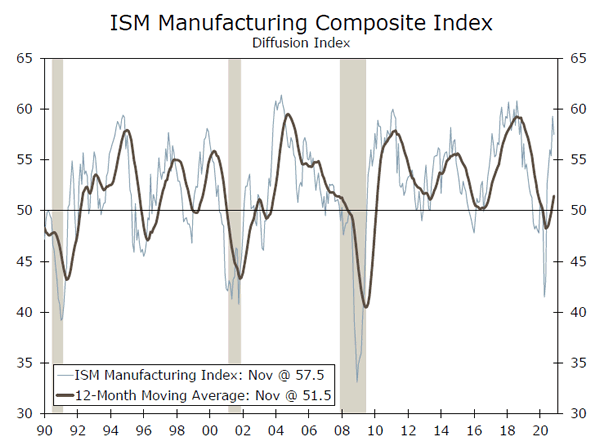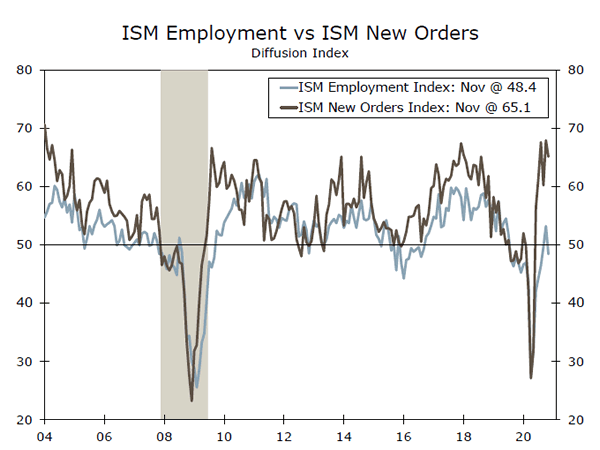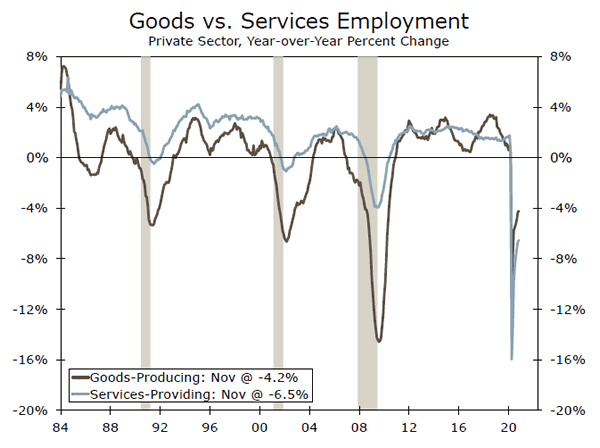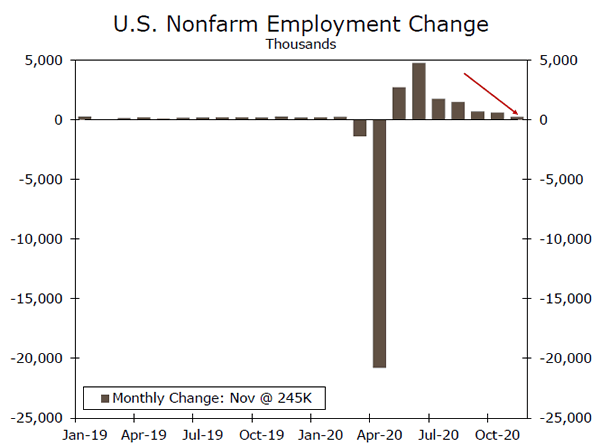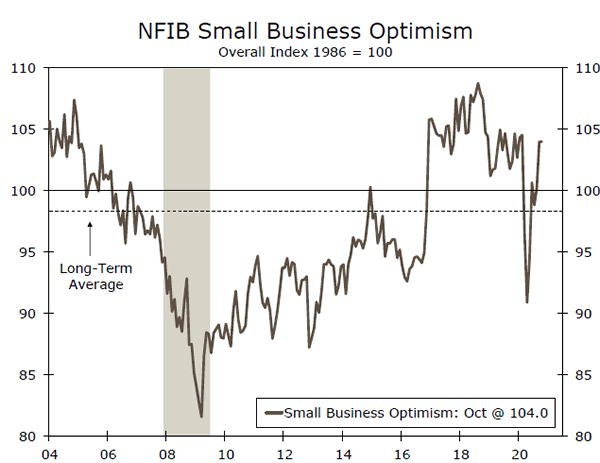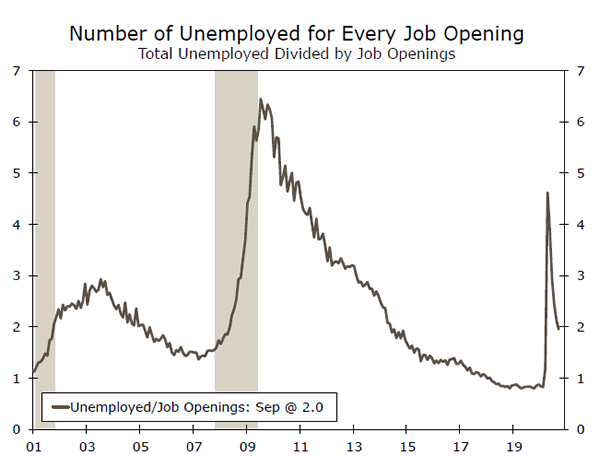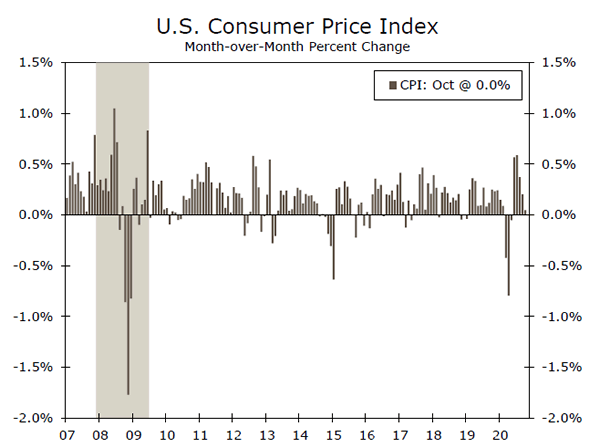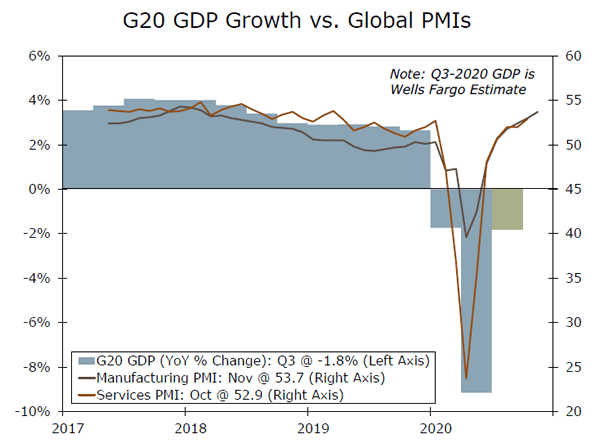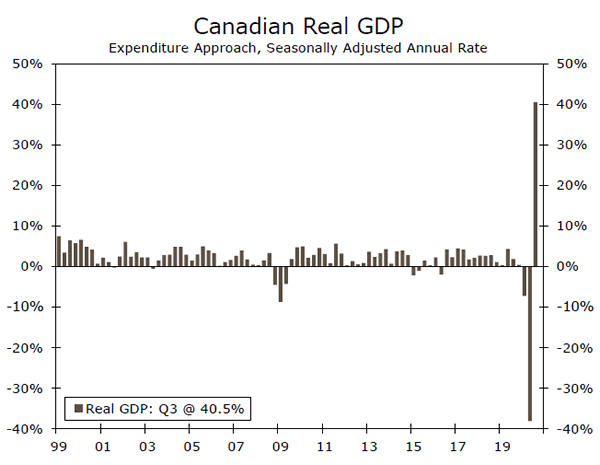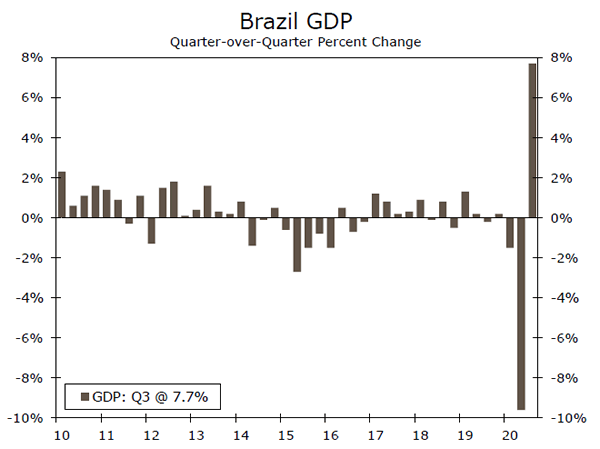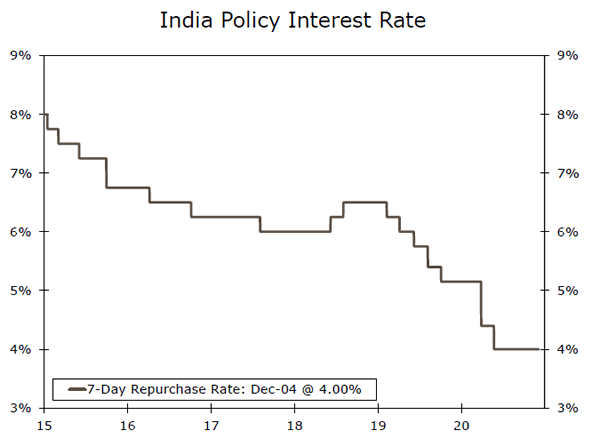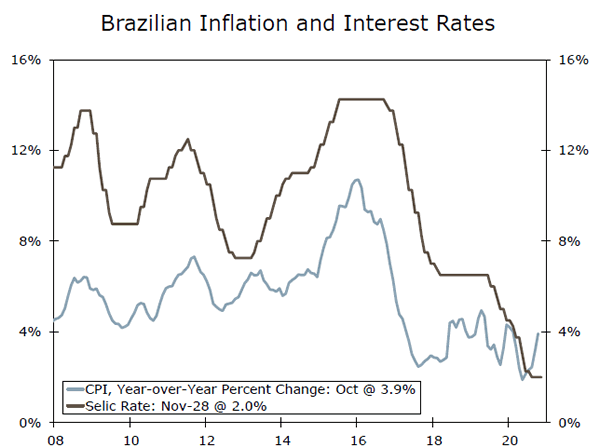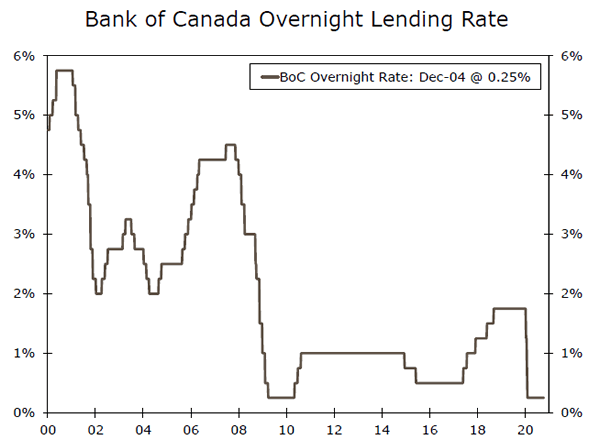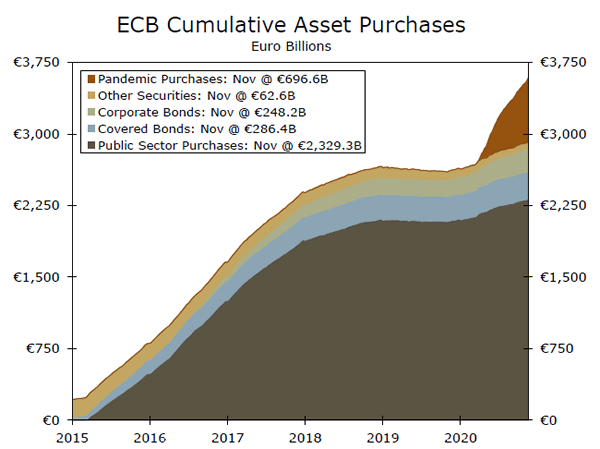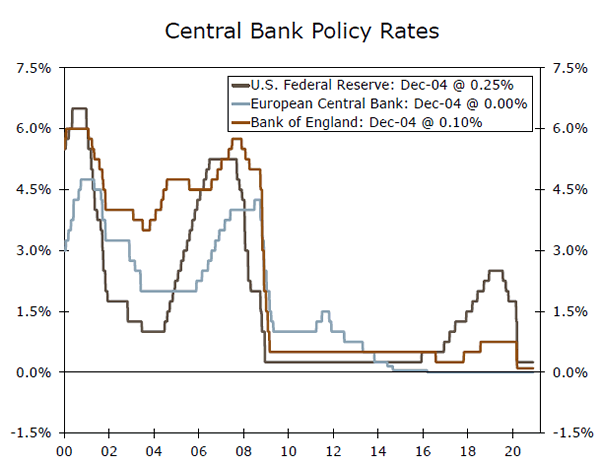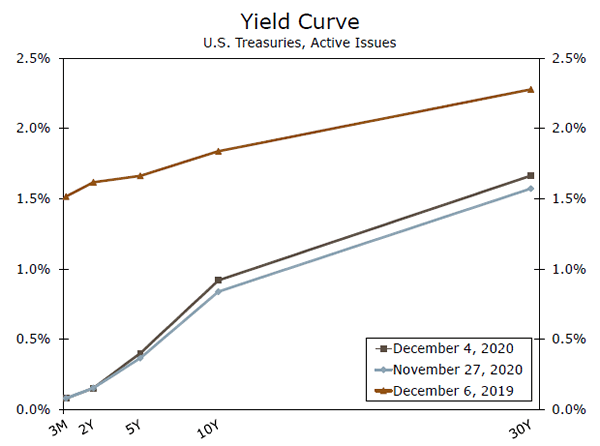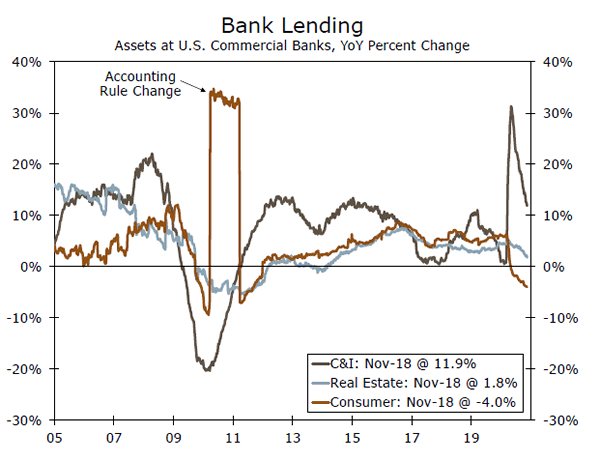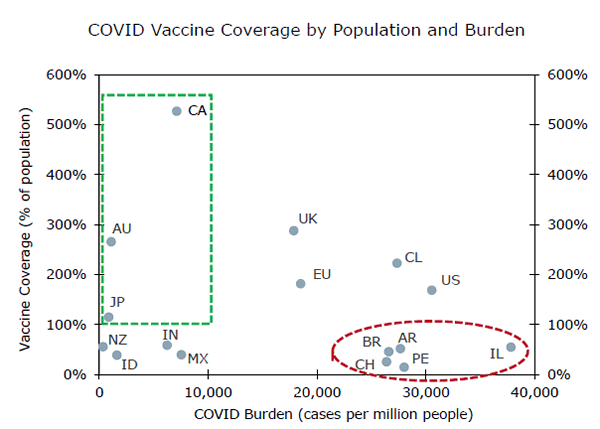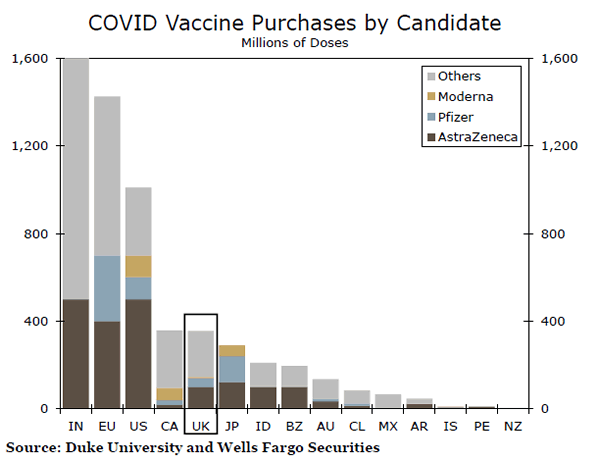U.S. Review
Data Continue to Reflect the Economy’s Resilience
- Manufacturing held up relatively well in November, despite a larger-than-expected dip in the ISM manufacturing survey. The nonfarm manufacturing survey rose slightly.
- Residential construction continues to ramp up, while the commercial construction pipeline appears to be winding down.
- Nonfarm employment rose by smaller-than-expected 245,000 in November, but there were many crosscurrents in the data.
- COVID infections appear to have topped out slightly before Thanksgiving but hospitalizations are still rising. Another spike in infections is widely expected in the coming weeks.
COVID Is Still Holding Sway Over the Economy
The latest spike in COVID infections is clearly evident in the latest round of economic reports. Consumers began to pull back from high-contact activities in late October and early November, negatively affecting restaurants, bars, entertainment venues and in-person shopping. Restaurant closings have also picked up, although we expect the fallout to become more apparent in the December and January data, when we believe the latest wave of COVID infections is likely to most heavily influence the economy.
This past week’s data show the economy is maintaining a great deal of resilience. The ISM Manufacturing Index fell 1.8 points to a still strong 57.5 in November. The ISM is a diffusion index and measures the breadth of strength or weakness in the factory sector rather than the magnitude. Any reading above 50 means more manufacturers see conditions at their business improving rather than weakening. The forward-looking indicators of the survey suggest that manufacturing activity should hold up well, even if the economy loses a bit of momentum over the next couple of months. While the new orders series fell slightly in November, it remains high at 65.1 and the backlog of unfilled orders continues to trend higher. Export orders are also improving and inventories of just about everything are low.
Most of the recent housing data show builders and realtors struggling to match supply with exceptionally strong demand. Home sales and single-family construction normally slow during the winter but are widely expected to slow less this year due to the shift in home buying in parts of the South and West where winter weather does not inhibit new construction. Mild fall weather also allowed for more construction than usual, leading to some strength in November construction payrolls. That said, pending home sales fell 1.1% in October, following a 2.0% drop the prior month. Part of that drop likely reflects incredibly thin for-sale inventories. Mortgage applications have also moderated on a sequential basis, hinting that the run-up in home sales and housing starts may be in for a pause.
Nonfarm employment rose by a smaller-than-expected 245,000 jobs in November. The winding down of temporary Census jobs again weighed on the headline increase, as government payrolls fell by 99,000 jobs. Employment in bluecollar professions continues to rebound. Manufacturing and construction each added 27,000 jobs in November. Employment in trucking and warehousing jumped by a whopping 145,000 jobs, much of which were at couriers and delivery firms. Of course part of that strength comes at the expense of brick and mortar retailers, which hired fewer workers for the holiday season. Mall-based retailers appear to be struggling the most, while discount stores, home improvement centers and other big-box chains continue to do well.
While the latest data show continued sequential growth, the rate of improvement is slowing and the proportion of industries adding jobs is also declining. The bulk of the impact from the most recent spike in COVID cases will show up in the December data, which will likely be dragged down further by the lack of hiring at retailers and renewed shutdowns at restaurants and entertainment venues.
U.S. Outlook
NFIB Small Business Optimism • Tuesday
Small business confidence held steady in October. The top-line index was unchanged at 104 during the month, a level which is vastly improved compared to earlier in the year. Looking beneath the surface, however, only four of the 10 sub-indices improved during the month. Businesses reported better sentiment surrounding expected sales, earnings, expected credit conditions and plans to increase inventories.
On the other hand, six sub-indices declined, notably “plans to hire” and “expect the economy to improve.” What’s more, the uncertainty index rose six points to 98, which is not unusual ahead of elections. Fast-rising COVID case counts, however, have led to heightened uncertainty among business owners. Considering the COVID situation has deteriorated further since October and odds of additional fiscal relief in the near-term remain low, it would not be surprising to see small business optimism slip a bit in November.
Previous: 104.0 Consensus: 102.5
JOLTS Job Openings • Wednesday
The labor market remains a key focus as COVID case counts continue to climb and lawmakers debate additional rounds of fiscal relief. The Jobs Opening and Labor Turnover Survey (JOLTS) is not as widely followed as other measures, but nevertheless offers valuable insights into the current state of the labor market. During September, the number of job openings increased to 6.44 million from 6.35 million in August. This was another step in the right direction, however job openings remain well below the 7.05 million level hit during September of last year.
Despite recent improvements, the next few months are still likely to be an uphill climb for the labor market. While job openings rose, the number of hirings fell to 5.87 million in September. Moreover, there are currently about two unemployed job seekers for every available job (chart on the left), which is still quite high compared to pre-pandemic levels.
Previous: 6.436 Million Consensus: 6.300 Million
CPI • Thursday
The Consumer Price Index (CPI) was unchanged during October and up 1.2% over the past 12 months. Broadly speaking, price pressures continue to be modest as overall demand for goods and services remain below pre-pandemic levels. The details of October’s report presented more of a mixed bag. For example, food prices rose 0.2% and energy prices advanced 0.1%. Apparel (-1.2%), medical care services (-0.3%) and used cars and trucks (-0.1%) all registered a monthly decline.
Looking ahead, inflation should continue to gradually move in an upward direction. A significant break out higher is unlikely, however. Shelter prices, which account for approximately 42% of the core CPI, rose a meager 0.1% for the third consecutive month in October, reflecting lower apartment rents and room rates at hotels. In short, muted gains in shelter prices will likely keep a lid on overall consumer price increases in the months ahead.
Previous: 0.0% Wells Fargo: 0.1% Consensus: 0.1% (Month-over-Month)
Global Review
Canada Q3 GDP Strong; Brazil Q3 GDP Mixed
- Canadian GDP data this week were relatively strong, with the economy posting the largest quarterly rise on record. With the government committed to fiscal stimulus and household disposable incomes still elevated, the outlook for Canada is still positive. Brazil on the other hand is mixed. Fiscal support has helped the economy improve through Q3, but with it likely to fade in 2021 the economy could see a fall in activity.
- The Reserve Bank of India held rates steady again this week as CPI inflation remains well above the central bank’s target range. Until a more sustained drop in inflation is achieved, rates are likely to stay on hold until late 2021.
Canada’s Economy Bounces Back
After a deep dive in the second quarter, Canada’s economy enjoyed a fairly solid bounce back during Q3. Overall GDP grew 40.5% quarter-over-quarter annualized, a bit less than forecast, but still the largest quarterly GDP gain on record. Despite the below forecast GDP print, the details were strong, as consumer spending rose at a 62.8% pace and business investment rose 82.4%. In terms of industries, service sector activity grew 42.9% quarter-over-quarter annualized, while manufacturing output grew at a moderately faster 46.8% pace. After a somewhat mechanical rebound as Canada’s economy reopened, the pace of economic recovery will surely slow in the quarters ahead, including during Q4-2020. That said, there are good reasons to expect the economic expansion to continue. In particular, given government support measures, household income trends remain very sound. For Q3-2020, household disposable incomes only fell 3.1% quarter-over-quarter (not annualized), but that was only a partial reversal of an 11.1% quarter-over-quarter surge in disposable income in Q2. In addition, the Canadian government is still committed to additional fiscal spending, which provides some support to the economy going forward.
Brazil Q3 Data Sending Mixed Signals
One of the worst COVID outbreaks in the world weighed on Brazil’s economy in the first half of the year. However, as confirmed cases gradually receded and Brazil’s economy started to reopen economic activity picked up significantly. Industrial production, retail sales and PMI data rebounded notably, while elevated fiscal support and aggressive monetary easing helped fuel consumer spending activity. The combination of improving leading indicators has been reflected in Q3 GDP data released this week as the economy expanded 7.7% quarter-over-quarter in the third quarter, the largest quarter of economic growth on record in Brazil. Despite the record increase, the Q3 GDP estimate was well-below consensus estimates, looking for an 8.7% rise. In our view, the miss against consensus could be related to households opting to slow spending habits as fiscal support is likely to taper off at the end of the year. With support such as direct payments to households likely to fade in the near future, Q4 growth and early 2021 GDP data could fall back to trend style growth rather quickly.
Reserve Bank of India Stays on Hold
With CPI still well-above the 6% upper bound of its inflation target range, the Reserve Bank of India opted to keep policy rates on hold again this week. The message from policymakers is that policy will remain accommodative; however, until CPI trends lower and falls into the RBI’s inflation target range, rates are likely to remain on hold. Following a strong Q3 GDP print, the RBI may have some leeway to keep rates higher than they would like as the economy seems to be on the long road to recovery. Nevertheless, India’s economy is still on pace for one of the worst annual contractions in the emerging markets this year as we forecast around a 9.0% contraction. Not all is bleak for India as the government has already purchased a large amount of COVID vaccine doses, the most in the world. Should India receive a vaccine early, upside for the economy could be realized.
Global Outlook
Brazil Inflation • Tuesday
With confirmed COVID cases receding, Brazil’s economy has been able to reopen and mobility has increased across the country. As a result, economic activity has increased, with leading indicators of GDP growth showing a firm rebound over the past few months. Inflation has also been steadily rising as the economy reopens, with October IPCA inflation just below 4% on a year-over-year basis. As of now, consensus forecasts expect inflation to continue to tick higher in November. With the economy recovering, inflation firming and the Brazilian currency exhibiting some stability, it is possible the combination of these dynamics will allow the Brazilian Central Bank to begin raising policy rates in early 2021. Market participants are pricing in a significant amount of hikes to Brazil’s Selic rate over the next 12 months; however, we believe policymakers will keep monetary policy accommodative for the time being. However, a sustained move higher in inflation could force us to adjust that view.
Previous: 3.92% Consensus: 4.18% (Year-over-Year)
Bank of Canada • Wednesday
The Bank of Canada (BoC) will meet next week to again assess monetary policy. With interest rates effectively at 0% in Canada, it is unlikely policymakers make any new adjustments to policy rates. However, with the Bank of Canada still engaged in asset purchases it is more likely policymakers use next week’s meeting to address the future path of its quantitative easing program. Since the global spread of the virus took shape, the BoC started its first QE program on record, purchasing C$5B of government bonds per week. More recently, the BoC scaled back the size of its asset purchases, buying C$4B of bonds per week. In our view, it is likely BoC policymakers address the future size of asset purchases as we head into 2021 and seek to provide market participants with guidance on whether and when asset purchases could be scaled back again. With the Bank of Canada easing off the monetary easing pedal, fiscal stimulus will likely take most of the burden for economic support going forward.
Previous: 0.25% Wells Fargo: 0.25% Consensus: 0.25%
European Central Bank • Thursday
Against a backdrop of building downside to the economic outlook for the Eurozone, the European Central Bank (ECB) will meet toward the end of next week to discuss monetary policy options. With policy rates already at -0.50%, we believe it is somewhat unlikely ECB policymakers will opt to lower interest rates further into negative territory. In our view, it is more likely policymakers instead chose to expand its asset purchase program, more specifically its pandemic emergency purchase program (PEPP). In addition to purchasing a larger amount of securities, we believe it likely the ECB will extend the duration of the program. As of now, the PEPP will last until June 2021 at a minimum; however, we believe it is likely the ECB will continue purchasing assets through the end of 2021, possibly even into 2022. Expanding the asset purchase program should help the Eurozone economy recover over the longer term and help boost inflation back into positive territory.
Previous: -0.50% Wells Fargo: -0.50% Consensus: -0.50% (Deposit Rate)
Point of View
Interest Rate Watch
Waller to Join FOMC
The Senate voted 48-47 on Thursday to confirm President Trump’s choice of Christopher Waller to become a member of the Board of Governors of the Federal Reserve System. Along with Judy Shelton, Waller was nominated by Trump in January of this year to join the Fed.
Waller is currently the Research Director at the Federal Reserve Bank of St. Louis and, unlike Shelton, he holds largely conventional views about monetary policy and the role of the Fed in the economy. Three Republican senators and all the members of the minority have opposed Shelton’s nomination, which has effectively doomed it. Once Waller formally takes his position as a Fed Governor, six seats on the seven-member Board will be filled. The Federal Reserve Board has not had a full complement of seven members since July 2013.
Unless Shelton is unexpectedly confirmed, Joe Biden will have the opportunity to appoint a Fed Governor after he takes the oath of office, as expected, in January, and he will have more opportunities to reshape the Fed Board in the next year or so. The term of Randal Quarles, who is the Vice Chair for Supervision, ends next October, and Vice Chair Clarida’s term comes to a close in January 2022. Biden will also have the opportunity to name a new Fed Chair, or re-nominate Jerome Powell, when his term as Chair ends in February 2022.
Other than the Chair, individual Governors have little influence on the overall settings of U.S. monetary policy. The Federal Open Market Committee (FOMC) is comprised of the members of the Board of Governors as well as each president of the 12 Federal Reserve Banks. Decisions about monetary policy are largely done in a collective fashion with each voting member of the FOMC having one vote.
In our view, Waller is clearly qualified to have a voice in the determination of U.S. monetary policy, but he hardly will be alone in that endeavor. Consequently, we remain of the view that the FOMC will maintain its current target range for its main policy rate between 0.00% and 0.25% through at least the end of 2022.
Credit Market Insights
Beige Book Update
The Fed’s latest Beige Book reported that firms across the 12 Federal Reserve Districts maintained positive outlooks through November, but optimism is waning. While most observed modest economic expansion over the past month and a half, four districts described little or no growth at all.
In business lending, bank contacts cited deteriorating loan conditions in the hard-hit retail and leisure & hospitality sectors. The Boston Fed reported that small retailers continued to struggle to make ends meet while grocery and big-box stores generally outperformed. The New York Fed also noted that spreads narrowed on all loan categories except for commercial & industrial loans. Further, the Dallas, Minneapolis and St. Louis Feds observed increases in payment deferral and nonperforming loans, nodding to weakness in commercial real estate portfolios.
In the consumer markets, banks mostly saw stable or increasing loan demand. Almost all the districts reported robust demand for residential mortgage purchase and refinancing applications. One contact at the Minneapolis Fed even referred to real estate demand as “relentless.”
Although lending standards have tightened and credit quality has remained solid, several districts expressed growing concern over the potential for loan losses next year. Pandemic uncertainty as well as the forthcoming expiration of eviction moratoriums and unemployment benefits led a majority to anticipate increased delinquencies across the board in 2021.
Topic of the Week
The U.K. Approved a COVID Vaccine
Over the past few weeks, there have been encouraging news on potential COVID vaccines as efficacy data of vaccine candidates’ manufactured by Pfizer, Moderna and AstraZeneca were better than expected. This week, the United Kingdom was the first western country to approve the Pfizer-BioNTech vaccine in an effort to vaccinate some of its citizens most affected by the COVID outbreak. According to the U.K.’s Department of Health and Social Care the vaccine will be available across the country next week after concluding that the vaccine met its strict standards of safety, quality and effectiveness. In addition, the government released guidance for the priority groups to receive the vaccine as well as the phases in which the distribution will occur. In phase one the government plans to prioritize the prevention of mortality and support the health and social care systems. The priority list includes residents in a care home for older adults and their staff, those 80 years of age and over and frontline health and social care workers, those 70 years and over and clinically extremely vulnerable individuals, as well as several other groups considered high priority. In focus for the second phase of vaccination is to further prevent hospitalization, as well as vaccinate those at increased risk of exposure to COVID due to their occupation such as first responders, the military and teachers, among others.
Data compiled by Duke University includes a variety of vaccine details, such as details on the COVID burden (i.e., COVID cases per million people) associated with multiple countries as well as the amount of vaccine doses already purchased by each country. The top chart indicates that the United Kingdom has already purchased enough vaccine doses to cover its entire population, but the COVID burden remains elevated, signaling that the country may face an uncertain interim period of growth until the vaccine is widely deployed. As of November 30, data indicates that the U.K. has purchased 40 million doses of the Pfizer vaccine, in particular (bottom chart). Despite the positive vaccine news, we still expect U.K. Q4 GDP growth to decline, and the overall economy to contract 11.2% year-over-year for full-year 2020.




